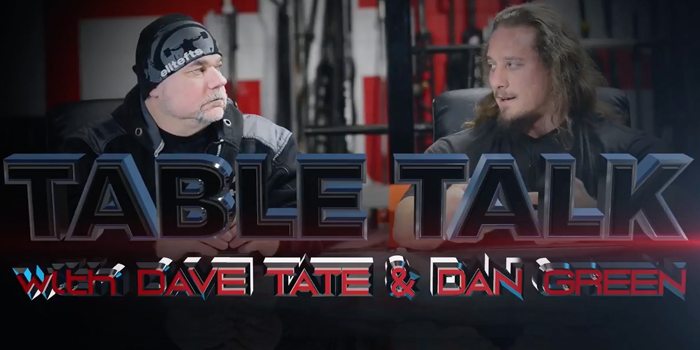
Exactly a year ago, Dan Green visited elitefts and sat down with Dave to discuss powerlifting, training philosophy, and how he trains people at Boss Barbell, his gym in Mountain View, California. Now Dan is back at the S4 Compound, tackling training questions with Dave in this special edition Table Talk.
For those of you unfamiliar with Dan Green (which, at this point, should be almost no one) here are some quick facts about his powerlifting career: he has held numerous all-time raw powerlifting records, many of them still standing. He has totaled 2065 pounds at 220 (a record at the time) and 2210 pounds at 242 (the standing all-time world record).
In today's video, Dave and Dan respond to a question relevant to any person entering the sport of powerlifting:
How should a new lifter build a base for powerlifting?
Dan begins by talking about how he learned when he first entered the sport of powerlifting: by reading articles, experimenting on his own, and talking to other lifters at meets. He talks about how, at 24 years old, he transitioned from training simply to get big and strong, to actually having directed training in preparation for a meet.
Dave then points out that Dan had spent almost 10 years training on his own, experimenting with his training, before ever entering powerlifting. He asks if this is an approach Dan would recommend to new lifters, or if he would tell them to immediately jump into powerlifting training. Dan answers this question by discussing technique. He says that the limitation in training, no matter what your goal is or what kind of sets and reps you're using, is technique. To build muscle and efficiency in the lifts—and to subject your body to the helpful kinds of stress rather than the harmful kinds—you have to focus on this from the start. After building proficiency in the lifts, you can do whatever you need in terms of sets, reps, and progressions.
Dave and Dan then discuss the importance of good technique not only on the main lifts but also on the supplemental lifts. For Dan, this means he has had to work to master multiple forms of squatting (high bar, front squat, SS Yoke Bar) and multiple forms of deadlifting (block pulls, deficits, other leverage changes). Similarly, bodybuilding accessory work shouldn't be done in a simple manner of counting your number of reps and going through the motions. You need to ask yourself if you are performing these accessory exercises in a manner that is going to benefit your main lifts. For instance, you could be doing rows in a way that will help your bench, or you could be doing rows in a way that will help your deadlift. Understanding the context is an important step to performing the exercises in a way that will drive progress.










